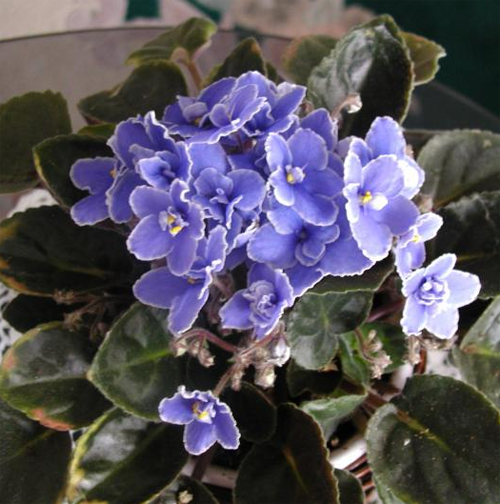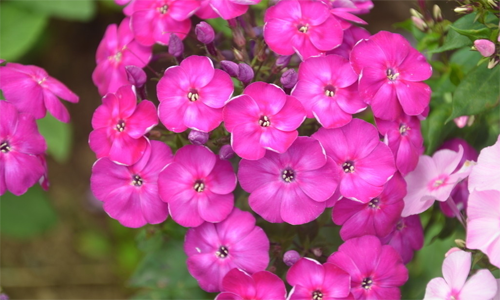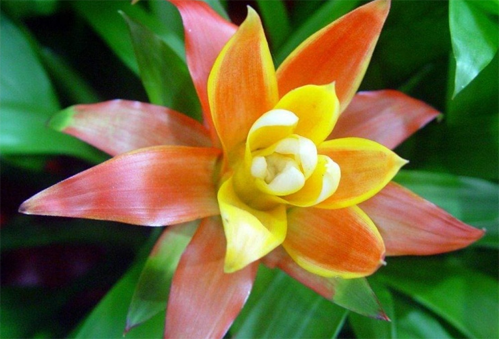How to breed African violets
The flowers of African violets are purple, or there are many people like them. What is the breeding method of African violets? How do African violets breed?

Culture methods of African violets:
1. The soil must be loose and breathable and have good water permeability. You can use the ratio of saprophyllite to perlite at 1:1, and then add some vermiculite, or you can use the ratio of humus soil to coarse sand at 1:1.
2. Watering should not be frequent, basin soil should not accumulate water, except that it is too cold in winter, it should be moist in other seasons.
3. The method of water provides us with more assurance, because we can see the root growth.
African pansy likes bright light, you can bask in a little bit of sunshine in the morning, a little light is enough!
They are still very easy to take care of, as long as the basin soil does not dry for too long or stagnant water for too long, there will be no problem!
It usually takes 8 months for the seedlings to grow to blossom, while the variegated leaves grow slowly.
Methods of propagation of African violets:
The first kind: hydroponic leaf cutting
First choose a pot of healthy African pansy, choose a few strong leaves, and cut off the leaves from the petiole with a sharp knife or scissors. The length of petiole is about 4 or 5 cm.
Note: do not get the roots or leaves of the plant.
Find a cup or bottle and fill it with water at room temperature (cold boiled water is also fine), insert the leaves in the cup, soak the petiole in the water, and then put the cup in a warm, ventilated place with bright light. Don't soak the leaves too much water! (the most suitable temperature for cultivation is about 20 degrees. Too high temperature affects the success rate)
Note: do not put the culture cup in direct sunlight, it will burn, but in a warm and bright place, after 2 or 4 weeks, you will see a root growing out of the petiole.
After growing roots, you can transplant the leaves into the slightly moist sandy soil, and each leaf with long roots can quickly grow new small leaves (buds)!
The second kind: soil culture leaf insertion
The method of reproduction is to insert the leaves directly into the slightly moist sandy soil. (the length of the petiole should be 4 to 5 centimeters, which will affect the germination rate.) the length of each leaf buried in the soil is 1 centimeter, which is too short and easy to rot. If you bury it for too long, it won't sprout!
Note: the small basin inserted by the leaf had better be small, a little bigger than the leaf, if in the large basin, the moist water retention is more, and the moisture goes slowly, easy to rot the leaf!
Many flower friends have tried this method, but the leaves are always rotten, how to return a responsibility? Is there no root powder?
In fact, the insertion of soil leaves does not need any rooting hormones at all (just a little bit). The most important trick is not to water it, but to use a thin film to support it and make it look like a tent, which can achieve the effect of moisturizing and heat preservation. About 2-4 weeks, the leaves will take root and sprout!
Four weeks later, the basin soil in the slightly moist film began to dry, at this time you can see the petiole director out of a new small leaves, very lovely buds, leaves growing in clusters, full of vitality! At this time, you need to transplant these seedlings into a new flowerpot, remember to transplant together with the soil, the success rate is also very high!
This is the end of the introduction on the breeding and breeding methods of African violets, and we should not hurry up with a few plants in our own home.
How do African violets reproduce African violets
African violets are a kind of flowers. African violets are flowers that people like to decorate and beautify the environment. How do African violets reproduce? Let's take a look at the breeding methods of African violets.
1. African Violet Leaf insertion Propagation
African Violet commonly used cutting propagation method, mainly for leaf cutting, after flowering to select robust leaves, petiole left 2 cm long cut off, slightly dry, inserted into the sand bed, maintain a high air humidity, room temperature 18-24 ℃, rooting 3 weeks after cutting, 2-3 months will produce seedlings, moved into 6 cm pot. In the process of cutting, vitamin ratio treatment was beneficial to the growth of African violets after rooting, and the petiole treated with 25 mg / L kinetin for 24 hours was beneficial to the formation of adventitious buds. It takes 4 to 6 months from cutting to flowering.
2. Stem insertion and propagation of African violets.
Stem insertion propagation is also a breeding method chosen by the African Violet Society, mainly after the flowers are withered in spring. Combined with turning basin and changing soil to divide underground tuber planting, the seedling is fast, but the plant shape is not good enough, at the same time, the growth is not exuberant because the plant is not renewed.
3. Tissue culture and reproduction of African violets.
At present, the more popular propagation method of African violets is tissue culture, with leaves, petioles and epidermis as explants. MS medium was added with 1 mg / L 6-benzylaminoadenine and 1 mg / 1 naphthylacetic acid. Adventitious buds appeared 4 weeks after inoculation, and rooting plantlets could be planted 3 months later. The plantlets were transplanted into the matrix of rotten leaf soil and peat bryophyte, and the survival rate was 100%. At present, African violet test-tube plantlets are produced in the United States, the Netherlands, Israel and other countries. However, there are more seedlings cultivated in this way, which is not suitable for family breeding.
4. the method of sowing and breeding of African violets
The sowing and propagation of African violets can be carried out in spring and autumn, and it is better to sow in autumn from September to October in greenhouse, with high germination rate, strong seedling growth, and more big flowers in the following spring. Sow in February and blossom in August, but the growth potential is worse and the flowering is less. The seeds of African violets are small, and the sowing pot soil should be fine. After sowing, the soil should not be covered, and it should be flattened. The optimum temperature for germination was 18-24 ℃, germinated 15-20 days after sowing, and transferred seedlings 2-3 months after sowing. At the seedling stage, pay attention to the basin soil should not be too wet. It usually takes 6-8 months from sowing to flowering.
How to propagate African Violet A complete Collection of breeding methods of African Violet
African violets are excellent indoor ornamental plants with short plants, handsome and elegant flowers and rich colors. Many flower lovers hope to breed more African violets, so how do African violets reproduce? Let's learn about it next.
I. A complete set of propagation methods of African violets
1. African Violet Leaf insertion Propagation
African Violet commonly used cutting propagation method, mainly for leaf cutting, after flowering to select robust leaves, petiole left 2 cm long cut off, slightly dry, inserted into the sand bed, maintain a high air humidity, room temperature 18-24 ℃, rooting 3 weeks after cutting, 2-3 months will produce seedlings, moved into 6 cm pot. In the process of cutting, vitamin ratio treatment was beneficial to the growth of African violets after rooting, and the petiole treated with 25 mg / L kinetin for 24 hours was beneficial to the formation of adventitious buds. It takes 4 to 6 months from cutting to flowering.
2. Stem insertion and propagation of African violets.
Stem insertion propagation is also a breeding method chosen by the African Violet Society, mainly after the flowers are withered in spring. Combined with turning basin and changing soil to divide underground tuber planting, the seedling is fast, but the plant shape is not good enough, at the same time, the growth is not exuberant because the plant is not renewed.
3. Tissue culture and reproduction of African violets.
At present, the more popular propagation method of African violets is tissue culture, with leaves, petioles and epidermis as explants. MS medium was added with 1 mg / L 6-benzylaminoadenine and 1 mg / 1 naphthylacetic acid. Adventitious buds appeared 4 weeks after inoculation, and rooting plantlets could be planted 3 months later. The plantlets were transplanted into the matrix of rotten leaf soil and peat bryophyte, and the survival rate was 100%. At present, African violet test-tube plantlets are produced in the United States, the Netherlands, Israel and other countries. However, there are more seedlings cultivated in this way, which is not suitable for family breeding.
4. the method of sowing and breeding of African violets
The sowing and propagation of African violets can be carried out in spring and autumn, and it is better to sow in autumn from September to October in greenhouse, with high germination rate, strong seedling growth, and more big flowers in the following spring. Sow in February and blossom in August, but the growth potential is worse and the flowering is less. The seeds of African violets are small, and the sowing pot soil should be fine. After sowing, the soil should not be covered, and it should be flattened. The optimum temperature for germination was 18-24 ℃, germinated 15-20 days after sowing, and transferred seedlings 2-3 months after sowing. At the seedling stage, pay attention to the basin soil should not be too wet. It usually takes 6-8 months from sowing to flowering.
The above is the introduction of African violets propagation methods, leaf insertion, stem insertion, tissue culture, sowing, we can choose a breeding method, reproduction of African violets, I hope it will be helpful to everyone.
- Prev

What is the breeding method and price of Beautiful Sakura
Beauty Sakura, as soon as I see this name, I have a question in my heart. What is the relationship between Sakura and cherry blossoms? The flowers of Beautiful Sakura are indeed very similar to those of cherry blossoms. What is the breeding method of Beautiful Sakura? What is the price of Beautiful Sakura? The breeding method of Beautiful Sakura: beautiful cherry likes sunshine and is not tolerant to shade.
- Next

Will the breeding methods and breeding of colorful leaf pineapple bear fruit?
When it comes to colored leaf pineapple, this is really quite common, many people have some at home, this is also a very good ornamental plant, many people like breeding very much, what is the breeding method of colored leaf pineapple? Will the colorful leaf pineapple bear fruit? Culture method of colored leaf pineapple: pot soil medium
Related
- Fuxing push coffee new agricultural production and marketing class: lack of small-scale processing plants
- Jujube rice field leisure farm deep ploughing Yilan for five years to create a space for organic food and play
- Nongyu Farm-A trial of organic papaya for brave women with advanced technology
- Four points for attention in the prevention and control of diseases and insect pests of edible fungi
- How to add nutrient solution to Edible Fungi
- Is there any good way to control edible fungus mites?
- Open Inoculation Technology of Edible Fungi
- Is there any clever way to use fertilizer for edible fungus in winter?
- What agents are used to kill the pathogens of edible fungi in the mushroom shed?
- Rapid drying of Edible Fungi

